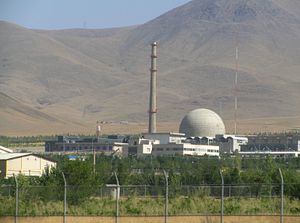On Monday, according to Iran’s semi-official Fars news agency, the Iranian government oversaw the removal the core of the 40 MW IR-40 heavy water reactor at Arak and filled it with cement. The move effectively decommissions the heavy water reactor, which had never been operational, and marks a critical step toward Iran implementing its obligations under last July’s Joint Comprehensive Plan of Action (JCPOA), an international deal to limit its nuclear program. Under the deal, Iran will redesign and rebuild the reactor to pursue “peaceful nuclear research.” Under the JCPOA, Arak may only produce non-weapons-grade plutonium (plutonium without a high concentration of the element’s Pu-239 isotope) during normal operation.
In technical terms, what Iran has accomplished will effectively bar the production of weapons-grade plutonium in the country for what is certain to be decades. In addition to redesigning the reactor, Iran will be required to ship all spent fuel rods out of the country. The latter represents one of the few provisions in the JCPOA that has no end date. The JCPOA notes that “All spent fuel from the redesigned Arak reactor, regardless of its origin, for the lifetime of the reactor, will be shipped out of Iran.” In general, Iran won’t be permitted to build a new heavy water reactor for 15 years under the JCPOA.
The development at Arak is particularly important as the issue of the IR-40 reactor was a major sticking point during negotiations for a final deal. As early as the November 2013 Joint Plan of Action, the issue of the Arak reactor appeared to be an intractable problem. The P5+1 did not see a final deal within the realm of possibility that did not include severe limitations of Iran’s heavy-water reactor at Arak. In early 2014, the Iranians indicated that a possible redesign of the Arak reactor was on the table.
All members of the so-called P5+1–a group of international powers including the United States, United Kingdom, France, Germany, China, and Russia–will participate in the redesign of the modernized reactor. The redesign will see the reactor come into operate as a hybrid water reactor that will use both heavy and light water as its coolant and moderator. The redesigned reactor will use uranium enriched at up to 3.67 percent as its fuel.
With the removal of the reactor core at Arak, “Implementation Day”–a crucial milestone in the JCPOA–should be imminent. According to a spokesperson for Iran’s atomic energy agency who spoke to Etemad, an Iranian newspaper, “Implementation of JCPOA will finish in the next 7 days.” On “Implementation Day,” the International Atomic Energy Agency verifies that Iran has complied with its requirements under the technical limitations portion of the JCPOA. Upon the IAEA’s certification that it has, Tehran will receive relief from U.S., European Union, and United Nations sanctions.

































